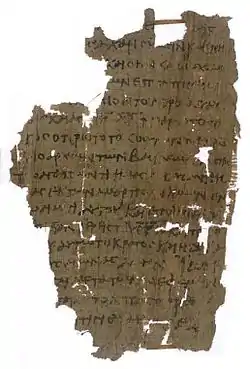Papyrus 18
Papyrus 18 (in the Gregory–Aland numbering), designated by 18, is an early copy of the New Testament in Greek. It is a papyrus manuscript containing the beginning of the Book of Revelation. It contains only Revelation 1:4–7. It is written against the fibres of the papyrus. On the other side of the papyrus is the ending of the book of Exodus. It is unclear whether the papyrus was a scroll of Exodus later reused for a copy of Revelation or a leaf from a codex with miscellaneous contents.[1] The two sides of the papyrus were copied in different hands, but the original editor of the papyrus did not think there was a great interval of time between the copying of the two sides. He assigned the Exodus to the third century and the Revelation to the third or early fourth century.[2]
| New Testament manuscript | |
 Revelation 1:4–7 | |
| Name | Oxyrhynchus Papyri 1079 |
|---|---|
| Text | Book of Revelation 1 † |
| Date | 3rd/4th century |
| Script | Greek |
| Found | Egypt |
| Now at | British Library |
| Cite | B. P. Grenfell & A. S. Hunt, Oxyrhynchus Papyri VIII, (London 1911), pp. 13 14 |
| Type | Alexandrian text-type |
| Category | I |
 |
 | |
Description
The Greek text of this manuscript is a representative of the Alexandrian text-type. Aland placed it in Category I.[3]
- λυσαντι ημας εκ — P18, אc, A, C, 2020, 2081, 2814
- λουσαντι ημας απο — P, 046, 94, 1006, 1859, 2042, 2065, 2073, 2138, 2432
It is currently housed at the British Library (Inv. 2053v) in London.[3][4]
Text
[Ιωαννης τα]ι[ς επτα] εκ[κλης]ιαις
[ταις εν τη] Ασια χαρις υμειν και ειρη
[νη απο ο ων] και ο ην και ο ερχομε
[νος και απο τ[ων επτα πνευμα
[των α] εν[ω]πιον του θρονου αυ
[τ]ου και απο ΙΗ ΧΡ ο μαρτυς ο πι
στος ο πρωτοτοκος των νεκρω
και ο αρχων των βασιλεων της γης
τω αγαμωντι ημας και λυσαντι η
[μ]ας εκ των αμαρτων ημων εν
[τ]ω αιματι αυτου και επιησεν ημ[ι]
[βα]σ[ιλ]ειαν ιερεις του θυa και π[α]τρι
[αυτο]υ. αυτω το κρατος και η δοξα
[εις το]υς αιωνας αμην ιδου
[ερχε]ται μετα των νεφελων
[και οψε]ται αυτον πας οφθαλ
[μος και ο]ιτινες αυτον εξε
a The scribe corrected this to τω θω
See also
References
- Brent Nongbri. "Losing a Curious Christian Scroll but Gaining a Curious Christian Codex: An Oxyrhynchus Papyrus of Exodus and Revelation," Novum Testamentum 55 (2013), pp. 77–88.
- Arthur S. Hunt. The Oxyrhynchus Papyri Part VIII. London: Egypt Exploration Fund, 1911, pp. 5 and 13.
- Aland, Kurt; Aland, Barbara (1995). The Text of the New Testament: An Introduction to the Critical Editions and to the Theory and Practice of Modern Textual Criticism. Erroll F. Rhodes (trans.). Grand Rapids: William B. Eerdmans Publishing Company. p. 97. ISBN 978-0-8028-4098-1.
- "Handschriftenliste". Münster: Institute for New Testament Textual Research. Retrieved 23 August 2011.
Further reading
- B. P., Grenfell; Hunt, A. S. (1911). Oxyrhynchus Papyri VIII. London: Egypt Exploration Fund. pp. 13–14.
- Brent Nongbri. "Losing a Curious Christian Scroll but Gaining a Curious Christian Codex: An Oxyrhynchus Papyrus of Exodus and Revelation," Novum Testamentum 55 (2013), pp. 77–88.
- Philip W. Comfort and David P. Barrett, The Text of the Earliest New Testament Greek Manuscripts. Wheaton, Illinois: Tyndale House Publishers Incorporated, 2001, pp. 103–105.
External links
- P. Oxy. VIII, 1079 from Papyrology at Oxford's "POxy: Oxyrhynchus Online"